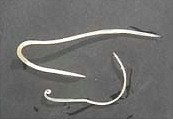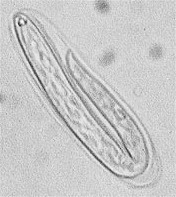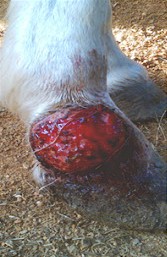Habronema is a genus of  parasitic roundworms that affects horses, donkeys and other equids worldwide. Other species of the same family affect also birds, amphibians and reptiles.
parasitic roundworms that affects horses, donkeys and other equids worldwide. Other species of the same family affect also birds, amphibians and reptiles.
They all occur worldwide, but prevalence and incidence vary a lot depending on the region and the climatic conditions. In France annual prevalence between 4% and 24% has been reported, in India up to 50%, in Germany up to 26.5%.
The most relevant species for horses are:
- Habronema muscae
- Habronema microstoma = Habronema majus
- Draschia megastoma = Habronema megastoma
These worms do not affect cattle, sheep, goats, pigs, dogs or cats.
The disease caused by Habronema worms is called habronemiasis or habronemosis.
Are horses infected with Habronema worms contagious for humans?
- NO: There is no evidence that these worms can infect humans.
You can find additional information in this site on the general biology of parasitic worms and/or roundworms.
Final location of Habronema spp
Predilection site of adult Habronema worms is the stomach. Larvae can be found in skin, the eyes, genitalia and even in the lungs.
Anatomy of Habronema spp

Adult Habronema spp are medium-sized worms, up to 3.2 cm in length, whereby females are about twice as log as males. Habronema muscae has a yellow to orange color, while other species are whitish.
As for other roundworms, the body of these worms is covered with a cuticle, which is flexible but rather tough. The worms have a tubular digestive system with two openings. The mouth of Habronema worms is provided with lip-like structures and has a cylindrical vestibulum.
They also have a nervous system but no excretory organs and no circulatory system, i.e. neither a heart nor blood vessels. Males have caudal wings (alae) and a copulatory bursa with two unequal spicules for attaching to the female during copulation. Morphology of the spicules is species-specific, important for species determination.
Habronema muscae deposits eggs that are very small (~11x45 micrometers), thin-shelled and have an elongated form. Each egg contains an already formed larva. Habronema microstoma and Draschia megastoma are viviparous, i.e. they do not deposit eggs but already hatched larvae.
Life cycle of Habronema spp
All Habronema species have an indirect life cycle, with several fly species and intermediate hosts, mainly houseflies (Musca domestica, mainly Habronema muscae and Draschia megastoma) and/or stable flies (Stomoxys calcitrans, mainly Habronema microstoma).
Adult female worms lay eggs or release L1-larvae in the stomach of the horses that are passed with the feces. These larvae are ingested by fly maggots that develop in the horse manure. These larvae complete development to infective L3 larvae inside the maggots within about 2 weeks. Once the fly maggots complete their development to adult flies, the infective L3 larvae migrate to the mouth of the flies from where they are deposited on the final host (horses, donkeys, etc.) visited by the flies. They are often deposited on humid parts of the host's body (eyes, nose, lips, genitalia, open wounds, etc.) to which many flies are attracted.
Once on the final host, L3 larvae are swallowed and get into the stomach where they complete development to adult worms within about 2 months. Infective L3-larvae can also infect the hosts if they swallow flies (e.g. with the food), or while grooming when the lick their own wounds infected with L3-larvae.
Larvae that do not reach the stomach but remain in the tissues (e.g. in the eyes, nostrils, lungs, genitalia, skin, etc.) do not complete development to adult worms.
Since occurrence of the flies is seasonal and depends strongly on climatic conditions (temperature, humidity, etc.), infections with these worms are also seasonal and peak during summer and early autumn.
The prepatent period (time between infection and first eggs shed) is about two months, suggesting that more than one generation can follow during a normal season in regions with a warm and humid climate.
Harm caused by Habronema spp, symptoms and diagnosis

Adult worms in the stomach (so-called gastric habronemiasis) of horses are usually not very pathogenic. They do not penetrate through or into the stomach wall as other parasitic worms do (e.g. Large and Small Strongyles), but remain in the lumen, mainly in the mucus surrounding the wall, and do not feed primarily on blood but on other digestive or body fluids.
In case of massive infections they can cause gastritis, colic, and other digestive disorders that can result in weight loss. Draschia megastoma can causes tumor-like swellings in the stomach wall that can burst and cause fatal peritonitis, but this is rather unusual.
Infective L3-larvae that are deposited on the eyes cause so-called ocular, ophthalmic or conjunctival habronemiasis that can cause inflammation of the eye envelopes (conjunctivitis) and the eyelids.
Infective L3-larvae deposited on skin wounds produce so-called skin or cutaneous habronemiasis, also known as "summer sores". They produce granulomatous skin reactions (erosions, swellings, etc.) that cause strong itching and are quite annoying for affected horses. Such infected wounds are difficult to heal, can become infected with secondary bacteria and may attract other fly species that can cause myiasis (e.g. screwworms).
Occasionally, infected L3-larvae deposited on the nostrils can migrate into the lungs of the host and cause so-called pulmonary habronemiasis. Small, hazelnut-like nodules can appear around the bronchi. Affected horses may show chronic cough, difficult breathing and reduced performance.
Little is known about natural and/or acquired immunity of horses to Habronema infections. Both young and adult horses are affected, suggesting that affected animals do not develop significant levels of immunity to these worms.
Diagnosis of gastric infections is difficult because the small eggs or L1-larvae passed in the feces are easily missed in fecal examinations. Non-healing skin wounds showing reddish to brownish color and containing rice-grain-like calcified material are typical for skin habronemiasis. Larvae may be found in scrappings of such wounds.
Prevention and control of Habronema spp
Non-chemical prevention
A key measure to reduce the risk of infection is adequate manure management to break the life cycle of the worms, both outdoors and indoors, since flies can develop in horse droppings both on pasture as well as inside stables and barns.
Regular manure removal (ideally daily, at least weekly) in stables and barns can significantly reduce the fly populations, provided that manure heaps elsewhere are adequately handled for preventing fly development (keep it dry, promote maggot predators, etc.). If possible manure should also be removed from pastures, or at least the fecal balls should be broken to accelerate drying and make it less suitable for maggot development.
Repellents that keep flies away from horses can also be used, but most of them have a very short effect, only hours or a few days.
For additional non-chemical control measures of flies read the specific article on houseflies and stable flies in this site.
So far no true vaccine is available against Habronema worms of horses. To learn more about vaccines against parasites of livestock and pets click here. Very little is known regarding the immune response of horses to Habronema infections and whether significant levels of immunity can be acquired after repeated exposure.
Biological control of Habronema worms (i.e. using its natural enemies) is so far not feasible. However, under certain circumstances manure-breeding flies can be successfully controlled using their natural enemies: click here to learn more about it.
You may be interested in an article in this site on medicinal plants against external and internal parasites.
Chemical control
Two major classes of anthelmintics are effective against Habronema worms and larvae in the gut:
- Benzimidazoles (febantel, fenbendazole, mebendazole, oxibendazole, etc), broad-spectrum anthelmintics effective against many parasitic worms of horses and livestock. However, a higher dosage than usually recommended is needed for Habronema control, and most products are not approved and/or have not been tested against these worms in most countries.
- Macrocyclic lactones (mainly ivermectin, moxidectin), broad-spectrum endectocides effective both against numerous roundworms and several external parasites as well. At the usual therapeutic dose moxidectin and ivermectin are effective against adult Habronema muscae. One or two treatments with ivermectin or moxidectin are also effective against cutaneous infections ("summer sores") as well.
Depending on the country most of these anthelmintics are available for oral administration as pastes, gels or other formulations for oral administration (e.g. tablets, drenches, feed additives). Very few are available as injectables. Many horse owners complain about the high prices of ivermectin formulations (mostly pastes or gels) for horses when compared with injectables for cattle and other livestock. The reason why ivermectin injectables are usually not used on horses is apparently that shortly after introduction, it was noticed that horses were more prone to develop severe clostridial infections at the injection site (due to contamination of the needles) and other undesired side effects than cattle or sheep. In addition, the pharmacokinetic behavior of ivermectin on horses is different than in ruminants. For these reasons oral pastes (or gels) were developed for horses that do not show such side effects.
Flies can also be controlled through various chemical means, either with insecticides for on animal and/or off-animal use that kill the adult flies, or with larvicides to treat the manure for killing the maggots. For specific information read the articles on houseflies and stable flies in this site. In some countries feed-through larvicides (mainly with cyromazine) are approved for use on horses that can contribute to reduce the fly populations in animal premises.
Since habronemiasis is caused by an allergic reaction of the host tissues to the worms, besides administration of an anthelmintic, additional medication may be considered (e.g. with corticosteroids).
Resistance of Habronema spp to anthelmintics
So far there are no reports on resistance of Habronema worms to anthelmintics.
This means that if an anthelmintic fails to achieve the expected efficacy against these worms, it is most likely not due to resistance but to incorrect use, which is the most frequent cause of product failure, or the product was not adequate for Habronema control.
Learn more about parasite resistance and how it develops.
|
Ask your veterinary doctor! If available, follow more specific national or regional recommendations for Habronema control. |